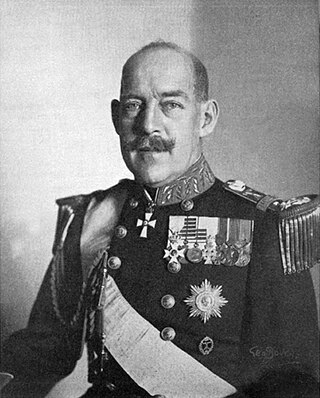
Paul was King of Greece, reigning from 1 April 1947 until his death on 6 March 1964.

George II was King of Greece from 27 September 1922 until 25 March 1924, and again from 25 November 1935 until his death on 1 April 1947.

Constantine I was King of Greece from 18 March 1913 to 11 June 1917 and from 19 December 1920 to 27 September 1922. He was commander-in-chief of the Hellenic Army during the unsuccessful Greco-Turkish War of 1897 and led the Greek forces during the successful Balkan Wars of 1912–1913, in which Greece expanded to include Thessaloniki, doubling in area and population. The eldest son of George I of Greece, he succeeded to the throne following his father's assassination in 1913.

Alexander was King of Greece from 11 June 1917 until his death in 1920.

George I was King of Greece from 30 March 1863 until his assassination in 1913.
An heir apparent or simply heir is a person who is first in an order of succession and cannot be displaced from inheriting by the birth of another person. A person who is first in the current order of succession but could be displaced by the birth of a more eligible heir is known as heir presumptive.

Eleftherios Kyriakou Venizelos was a Cretan Greek statesman and prominent leader of the Greek national liberation movement. He is noted for his contribution to the expansion of Greece and promotion of liberal-democratic policies. As leader of the Liberal Party, he held office as prime minister of Greece for over 12 years, spanning eight terms between 1910 and 1933. During his governance, Venizelos entered in diplomatic cooperation with the Great Powers and had profound influence on the internal and external affairs of Greece. He has therefore been labelled as "The Maker of Modern Greece" and is still widely known as the "Ethnarch".

Alexandros Zaimis was a Greek politician who served as Greece's Prime Minister, Minister of the Interior, Minister of Justice, and High Commissioner of Crete. He served as Prime Minister six times. Although he was a leader of the monarchist faction, Zaimis was the third and last President of the Second Hellenic Republic.

The Danish Act of Succession, adopted on 5 June 1953, restricts the throne to those descended from Christian X and his wife, Alexandrine of Mecklenburg-Schwerin, through approved marriages. By a change in the law in 2009, succession is governed by absolute primogeniture.
The following lists events that happened during 1920 in Greece.

Aspasia Manou was a Greek aristocrat who became the wife of Alexander I, King of Greece. Due to the controversy over her marriage, she was styled Madame Manou instead of "Queen Aspasia", until recognized as Princess Aspasia of Greece and Denmark after Alexander's death and the restoration of King Constantine I, on 10 September 1922. Through her marriage, she and her descendants were the only ethnically Greek members of the Greek royal family, which originated in Denmark.

Olga Constantinovna of Russia was Queen of Greece as the wife of King George I. She was briefly the regent of Greece in 1920.

The Danish royal family is the dynastic family of the monarch of Denmark. While some members of the Danish royal family hold the title of Prince(ss) of Denmark, descendants of Margrethe II additionally bear the title Count(ess) of Monpezat. Children of the monarch are accorded the style of His/Her Royal Highness. The King and Queen are styled Majesty.

Sophia of Prussia was Queen of Greece from 1913 to 1917 and from 1920 to 1922 as the wife of King Constantine I.

Pavlos Kountouriotis was a Greek admiral who served during the Balkan Wars, was regent of Greece, and the first president of the Second Hellenic Republic. In total he served four times as head of the Greek state, the most times in the history of the seat.

Helen of Greece and Denmark was the queen mother of Romania during the reign of her son King Michael I (1940–1947). She was noted for her humanitarian efforts to save Romanian Jews during World War II, which led to her being awarded by the State of Israel with the honorific of Righteous Among the Nations in 1993.

The currently deposed Greek royal family was the ruling family of the Kingdom of Greece from 1863 to 1924 and again from 1935 to 1973. The family is a branch of the Danish royal family, itself a cadet branch of the House of Glücksburg. The family had replaced the House of Wittelsbach that previously ruled Greece from 1832 to 1862. The first monarch was George I of Greece, the second son of King Christian IX of Denmark. The current head of the family is Pavlos, who assumed the role on 10 January 2023 upon the death of his father, former King Constantine II.

The House of Mukhrani is a Georgian princely family that is a branch of the former royal dynasty of Bagrationi, from which it sprang early in the 16th century, receiving in appanage the domain of Mukhrani, in the Kingdom of Kartli. The family — currently the seniormost genealogical line of the entire Bagrationi dynasty — has since been known as Mukhranbatoni.

The collapse of the Georgian realm was a political and territorial fragmentation process that resulted in the dynastic triumvirate military conflict of the Bagrationi monarchs and war of succession in the united Kingdom of Georgia culminating during the second half of the 15th century.


















